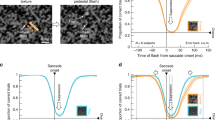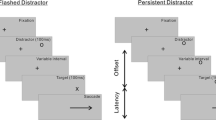Abstract
The remote distractor effect is a robust finding whereby a saccade to a lateralised visual target is delayed by the simultaneous, or near simultaneous, onset of a distractor in the opposite hemifield. Saccadic inhibition is a more recently discovered phenomenon whereby a transient change to the scene during a visual task induces a depression in saccadic frequency beginning within 70 ms, and maximal around 90–100 ms. We assessed whether saccadic inhibition is responsible for the increase in saccadic latency induced by remote distractors. Participants performed a simple saccadic task in which the delay between target and distractor was varied between 0, 25, 50, 100 and 150 ms. Examination of the distributions of saccadic latencies showed that each distractor produced a discrete dip in saccadic frequency, time-locked to distractor onset, conforming closely to the character of saccadic inhibition. We conclude that saccadic inhibition underlies the remote distractor effect.



Similar content being viewed by others
Notes
The difference histograms in Fig. 2 are plotted as absolute differences from baseline, rather than differences as proportions of baseline, because the estimates of proportional difference become noisy and unreliable when the baseline frequency is close to zero (i.e. the denominator term is small).
References
Braun D, Breitmeyer BG (1990) Effects of reappearance of fixated and attended stimuli upon saccadic reaction time. Exp Brain Res 81:318–324
Findlay JM, Walker R (1999) A model of saccade generation based on parallel processing and competitive inhibition. Behav Brain Sci 22:661–675
Lévy-Schoen A (1969) Détermination et latence de la réponse oculomotrice à deux stimulus simultanés ou successifs selon leur excentricité relative. L’Année Psychol 69:373–392
Reingold EM, Stampe DM (1999) Saccadic inhibition in complex visual tasks. In: Becker W, Deubel H, Mergner T (eds) Current oculomotor research: physiological and psychological aspects. Plenum, London, pp 249–255
Reingold EM, Stampe DM (2000) Saccadic inhibition and gaze contingent research paradigms. In: Kennedy A, Radach R, Heller D, Pynte J (eds) Reading as a perceptual process. Elsevier, Amsterdam, pp 119–145
Reingold EM, Stampe DM (2002) Saccadic inhibition in voluntary and reflexive saccades. J Cogn Neurosci 14:371–388
Reingold EM, Stampe DM (2003) Using the saccadic inhibition paradigm to investigate saccadic control in reading. In: Hyona J, Radach R, Deubel H (eds) The mind’s eye: cognitive and applied aspects of eye movements. Elsevier, Amsterdam, pp 347–360
Reingold EM, Stampe DM (2004) Saccadic inhibition in reading. J Exp Psychol Hum Percept Perform 30:194–211
Ross LE, Ross SM (1980) Saccade latency and warning signals: stimulus onset, offset, and change as warning events. Percept Psychophys 27:251–257
Ross SM, Ross LE (1981) Saccade latency and warning signals: effects of term and short-term monocular deprivation upon oculomotor function in the auditory and visual offset and onset. Percept Psychophys 29:429–437
Walker R, Kentridge RW, Findlay JM (1995) Independent contributions of the orienting of attention, fixation offset and bilateral stimulation on human saccadic latency. Exp Brain Res 103:294–310
Walker R, Deubel H, Schneider WX, Findlay JM (1997) Effect of remote distractors on saccade programming: evidence for an extended fixation zone. J Neurophysiol 78:1108–1119
Weber H, Fischer B (1994) Differential effects of non-target stimuli on the occurrence of express saccades in man. Vision Res 34:1883–1891
Acknowledgments
The authors are grateful to James Brockmole and John Henderson for helpful discussion of these issues.
Author information
Authors and Affiliations
Corresponding author
Rights and permissions
About this article
Cite this article
Buonocore, A., McIntosh, R.D. Saccadic inhibition underlies the remote distractor effect. Exp Brain Res 191, 117–122 (2008). https://doi.org/10.1007/s00221-008-1558-7
Received:
Accepted:
Published:
Issue Date:
DOI: https://doi.org/10.1007/s00221-008-1558-7




